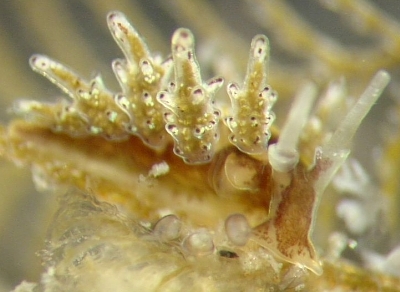
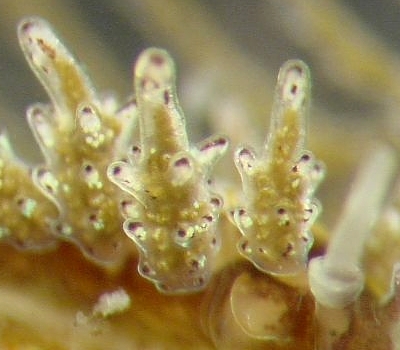
Doto koenneckeri
Lemche, 1976
Order: NUDIBRANCHIA
Suborder: DENDRONOTINA
Family: Dotidae
DISTRIBUTION
Europe, from Scotland to the Mediterranean.
PHOTO
'La digue', Port-Leucate , 3m, France, Mediterranean, 16 May 2005. Length: 5 - 6 mm. Photographer: Marina Poddubetskaia Ossokine
The body is translucent cream or whitish with a heavy pigmentation of brown on the sides, the dorsum, and the head. There is a unpigmented band down each side of the body between the cerata. The cerata ate transparent with the brownish digestive gland showing through. There are a few opaque white glands? in the tubercles, and at the tips of each ceratal tuercle there is a dark purplish mark. Picton & Morrow (1994) characterise this purplish mark as 'comma shaped' and distinguish it from the 'perfect' spot found in other species of Doto.
The ceratal tubercles, especially the terminal one, are very elongate. Picton & Morrow (1994) report that this species feeds on the hydroid Aglaophenia pluma.
Note: Previously on the Forum as Doto sp. 3.
-
Lemche, H. (1976). New British species of Doto Oken, 1815 (Mollusca: Opisthobranchia). Journal of the Marine Biological Association, United Kingdom, 56: 691-706
-
Picton, B. E. and Morrow, C. C. (1994) A Field Guide to the Nudibranchs of the British Isles. London, Immel Publishing Ltd. 143pp.
Rudman, W.B., 2006 (April 28) Doto koenneckeri Lemche, 1976. [In] Sea Slug Forum. Australian Museum, Sydney. Available from http://www.seaslugforum.net/find/dotokoen
Related messages
Doto koenneckeri feeding, laying eggs and predation ?
April 14, 2010
From: Dominique Horst
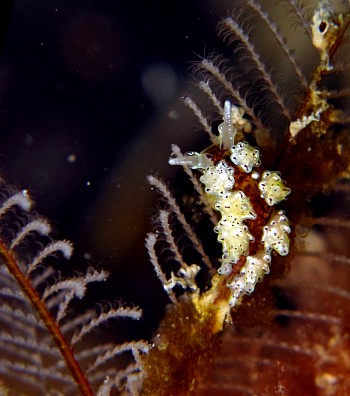
Hi Bill,
These all should be Doto koenneckeri.
All specimens were living and feeding on the hydroid Aglaophenia sp.
One is laying eggs.
The systematic presence of Caprella sp suggests that may be they are interested in eating the Doto eggs, but I have no confirmation about this predation?
Locality: Banyuls, 8m, France, Mediterranean sea, 27 March 2010. Length: 5 mm. Photographer: Dominique Horst.
Kind regards,
Dominique
dominique.horst@wanadoo.fr
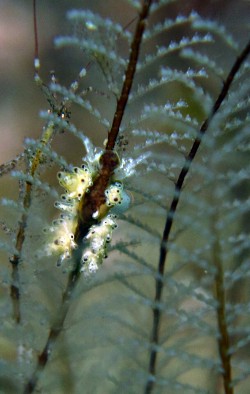
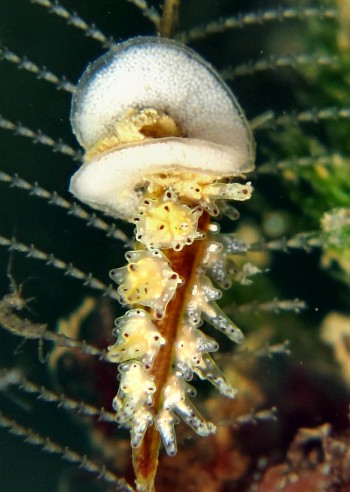
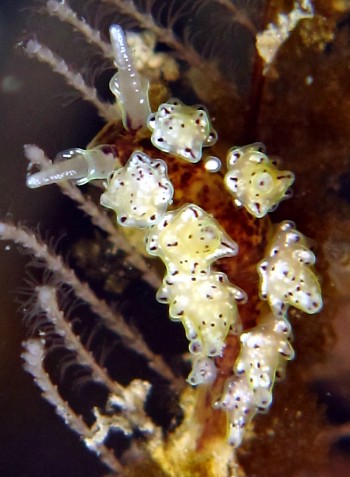
Thanks Dom,
The purplish marks on your animals certainly fit Bernard Picton's description as 'comma-like' so I would agree with your identification.
As I noted in an earlier message [#20296] caprellids appear to co-exist with at least some hydroid dwelling nudibranchs.
Best wishes,
Bill Rudman
Doto koenneckeri - food and eggs
April 29, 2006
From: Marina Poddubetskaia Ossokine
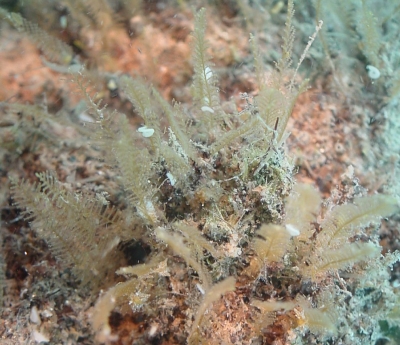
Dear Bill,
To complete my previous message [#16427], here are the related hydroid Aglaophenia and some egg-ribbons.
Locality: 'La digue', Port-Leucate , 3m, France, Mediterranean, 16 May 2005. Length: (5) : 6mm / (6) : 3mm. Photographer: Marina Poddubetskaia Ossokine.
Best wishes,
Marina.
Nembro website
nembro@nembro.info
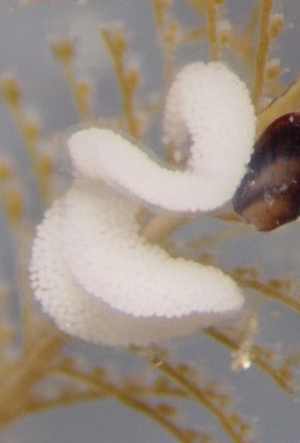
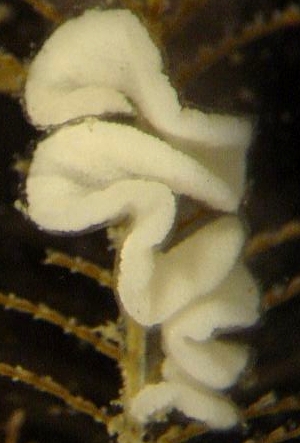
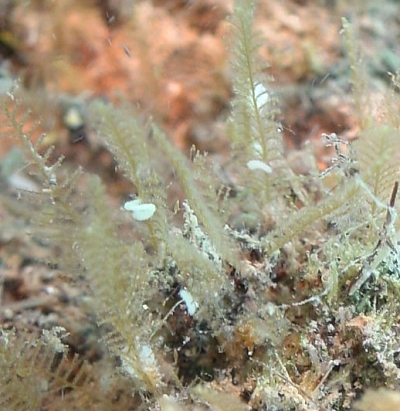
Dear Marina,
Thanks for this very useful background information. It's always a happy sight in the field to see a clump of hydroids with white egg masses on them like this, as it often means that adult slugs will be there. Unfortunately it can sometimes be a message that the adults have done their job and either died, or eaten all the polyps and left to look for food elsewhere.
Best wishes,
Bill Rudman
Doto koenneckeri from French Mediterranean
April 29, 2006
From: Marina Poddubetskaia Ossokine
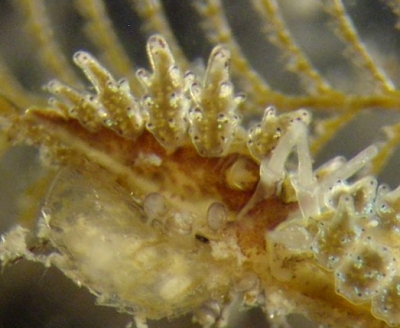
Dear Bill,
I see you have few photos of Doto koenneckeri on the Forum. So, here are some colour forms of what I think are Doto koenneckeri. I distinguish this species according to the very long terminal ceratal tubercles.
Locality: 'La digue', Port-Leucate , 3m, France, Mediterranean, 16 May 2005. Length: 5 - 6 mm. Photographer: Marina Poddubetskaia Ossokine.
Best wishes,
Marina.
Nembro website
nembro@nembro.info
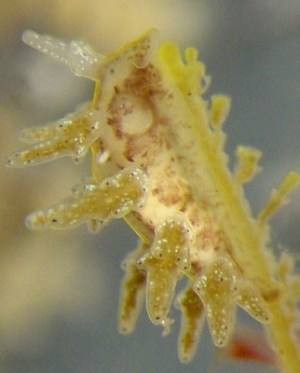
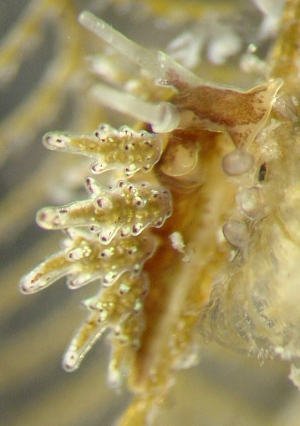
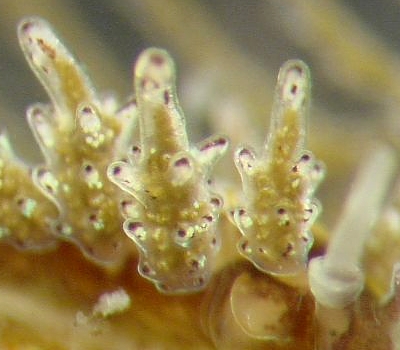
Dear Marina,
Thanks for some better photos of this species. It has enabled me to update the Fact Sheet. I see that Bernard Picton also considers the shape of the purple spots to be distinctive in this species - 'comma shaped' rather than circular. In the close-up alongside I can see what he means.
Best wishes,
Bill Rudman
Doto sp. 3 from Spain
February 12, 2002
From: Miquel Pontes
Prof.Urgorri kindly suggested me that, despite the pictures are not very clear, the Doto in my earlier message is Doto koenneckeri feeding on Aglaophenia.
Prof.Dr.Victoriano Urgorri can be contacted at
Laboratorio de Zooloxía Mariña
Departamento de Bioloxía Animal
Universidade de Santiago de Compostela
Spain
E-Mail: bavituco@usc.es
Miquel Pontes
mpontes@marenostrum.org
Pontes, M., 2002 (Feb 12) Doto sp. 3 from Spain. [Message in] Sea Slug Forum. Australian Museum, Sydney. Available from http://www.seaslugforum.net/find/6190Thanks Miquel,
It's nice to have an 'unknown' identified.
Best wishes,
Bill Rudman
Doto sp. from Spain
June 8, 1999
From: Miquel Pontes
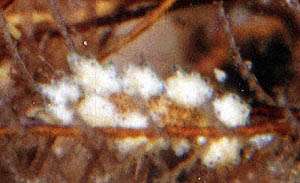
Here I enclose three pictures we shot two weeks ago in the Costa Brava, the Spanish North East coast, at a depth of about 16 meters.
We're interested on identifying the nudibranch displayed on them, that we believe it is a Doto.
It was feeding on an Aglaophenia cnidarian (sea plumes). We cannot determine the species and we have found almost no information on it. Could anyone help us ?
These pictures are not good because the animal was really tiny (about 3-4 mm) and I'm afraid they were a bit out of focus.
Miquel Pontes
mpontes@marenostrum.org
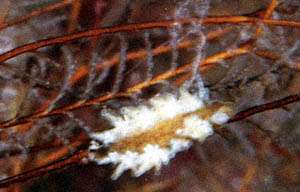
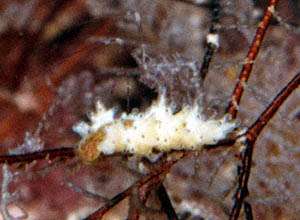
Dear Miquel,
I showed a few people on Sicily the photos but they were not sure of the identity. Hopefully some of the participants from Spain and Portugal will have a second look and suggest a name. Atlantic species of Doto are often quite difficult to identify but hopefully your photos are clear enough for someone to recognise the species.
Best wishes,
Bill Rudman.
